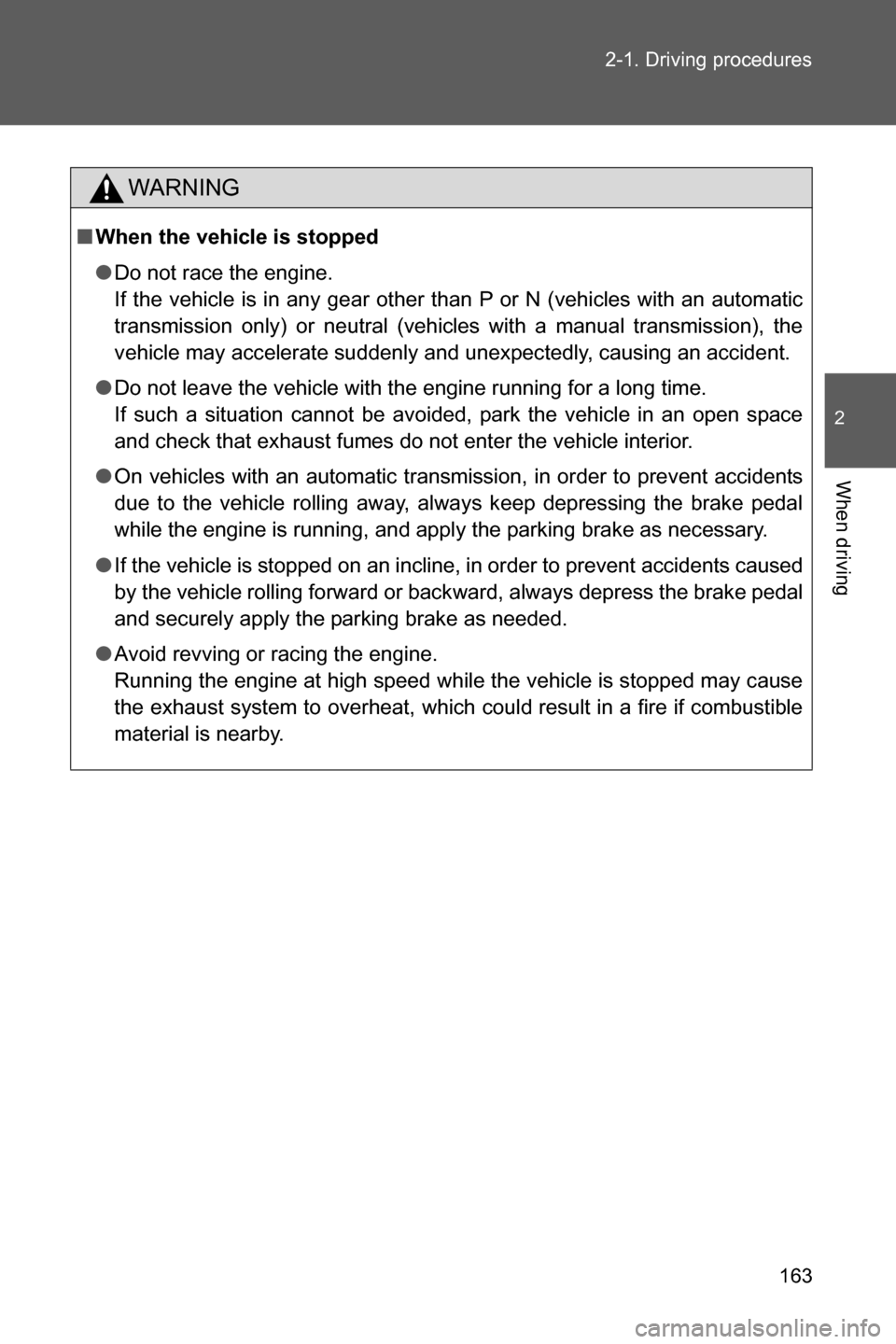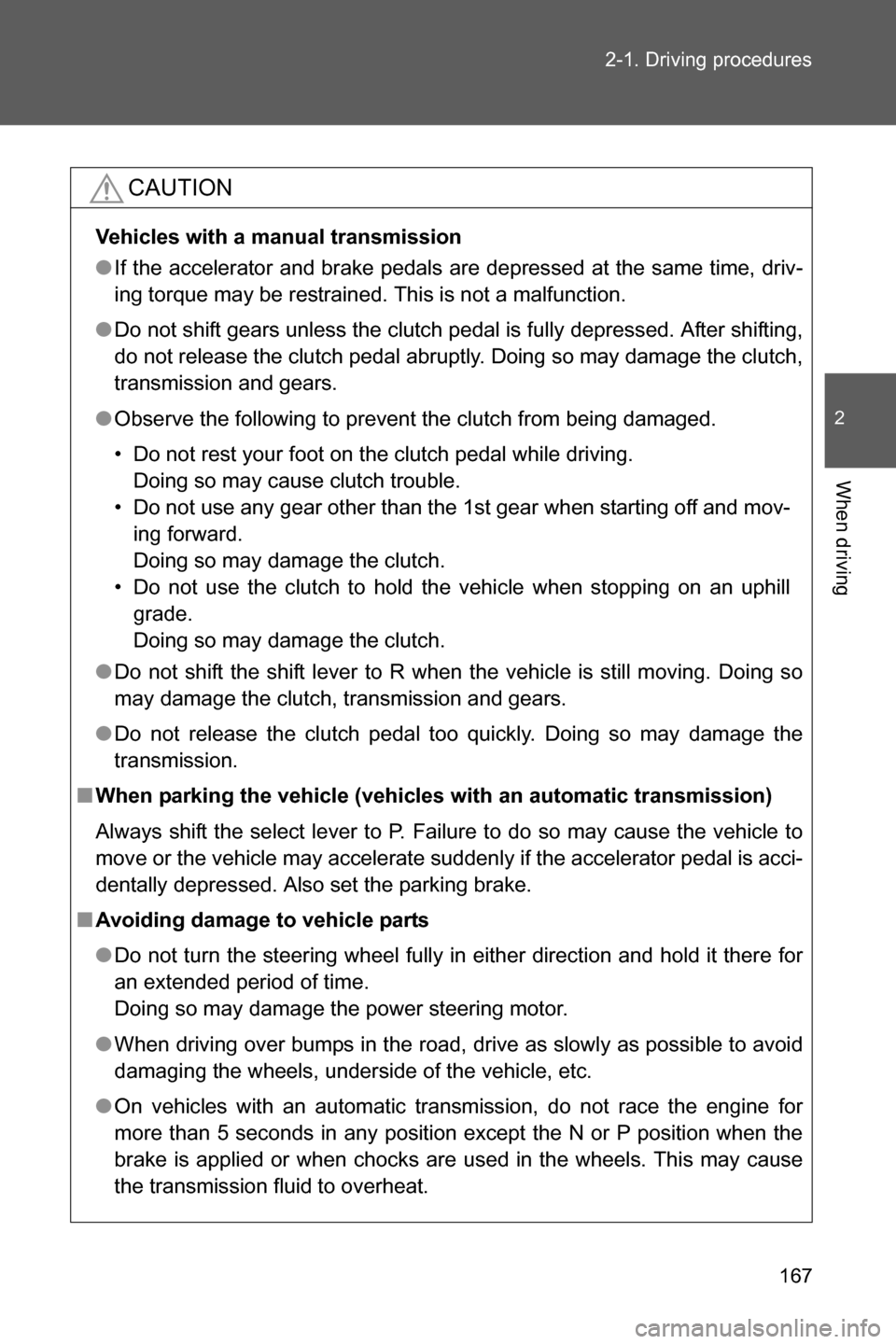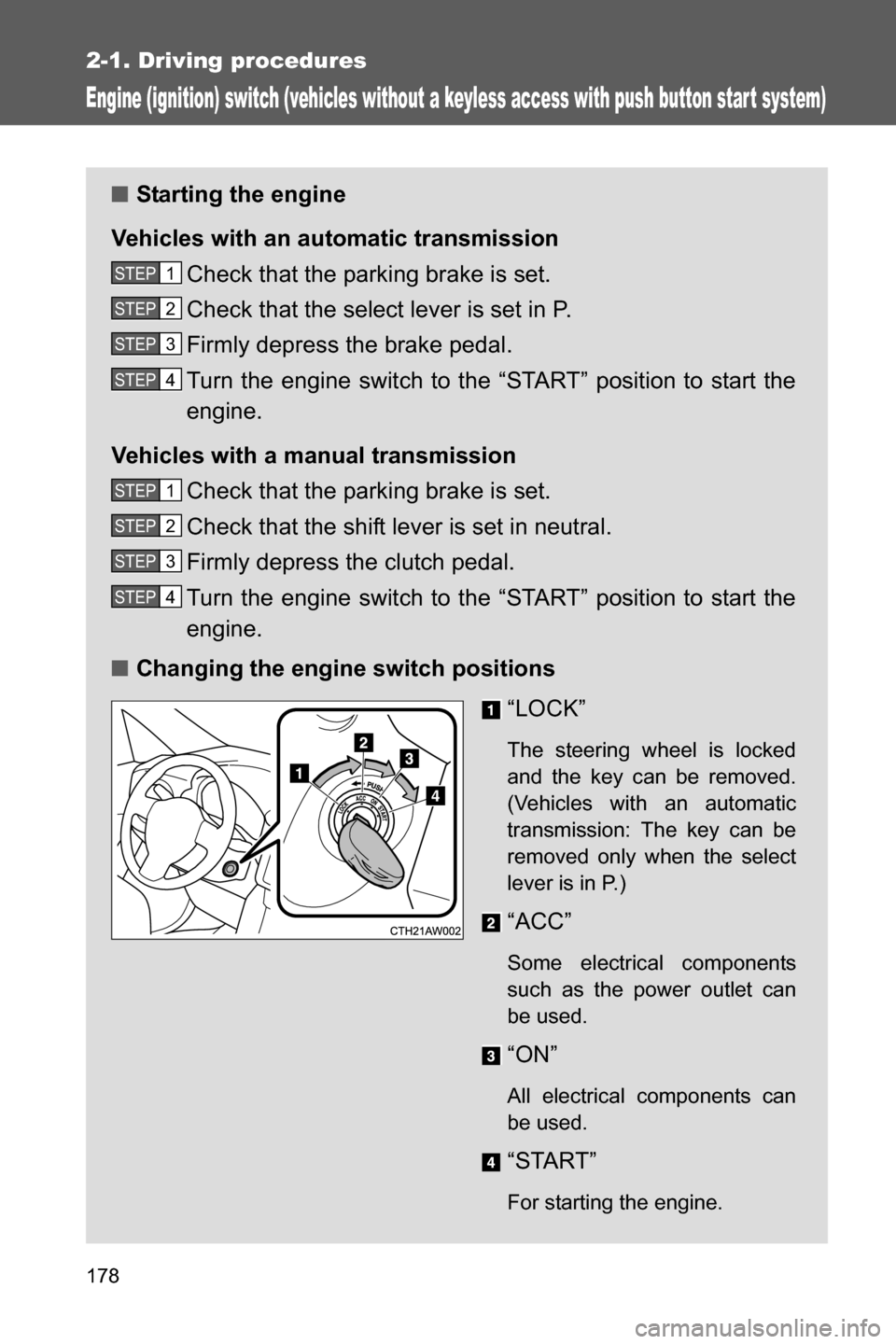Page 165 of 540

163 2-1. Driving procedures
2
When driving
WARNING
■When the vehicle is stopped
●Do not race the engine.
If the vehicle is in any gear other than P or N (vehicles with an automatic
transmission only) or neutral (vehicles with a manual transmission), the
vehicle may accelerate suddenly and unexpectedly, causing an accident.
●Do not leave the vehicle with the engine running for a long time.
If such a situation cannot be avoided, park the vehicle in an open space
and check that exhaust fumes do not enter the vehicle interior.
●On vehicles with an automatic transmission, in order to prevent accidents
due to the vehicle rolling away, always keep depressing the brake pedal
while the engine is running, and apply the parking brake as necessary.
●If the vehicle is stopped on an incline, in order to prevent accidents caused
by the vehicle rolling forward or backward, always depress the brake pedal
and securely apply the parking brake as needed.
●Avoid revving or racing the engine.
Running the engine at high speed while the vehicle is stopped may cause
the exhaust system to overheat, which could result in a fire if combustible
material is nearby.
Page 169 of 540

167 2-1. Driving procedures
2
When driving
CAUTION
Vehicles with a manual transmission
●If the accelerator and brake pedals are depressed at the same time, driv-
ing torque may be restrained. This is not a malfunction.
●Do not shift gears unless the clutch pedal is fully depressed. After shifting,
do not release the clutch pedal abruptly. Doing so may damage the clutch,
transmission and gears.
●Observe the following to prevent the clutch from being damaged.
• Do not rest your foot on the clutch pedal while driving.
Doing so may cause clutch trouble.
• Do not use any gear other than the 1st gear when starting off and mov-
ing forward.
Doing so may damage the clutch.
• Do not use the clutch to hold the vehicle when stopping on an uphill
grade.
Doing so may damage the clutch.
●Do not shift the shift lever to R when the vehicle is still moving. Doing so
may damage the clutch, transmission and gears.
●Do not release the clutch pedal too quickly. Doing so may damage the
transmission.
■When parking the vehicle (vehicles with an automatic transmission)
Always shift the select lever to P. Failure to do so may cause the vehicle to
move or the vehicle may accelerate suddenly if the accelerator pedal is acci-
dentally depressed. Also set the parking brake.
■Avoiding damage to vehicle parts
●Do not turn the steering wheel fully in either direction and hold it there for
an extended period of time.
Doing so may damage the power steering motor.
●When driving over bumps in the road, drive as slowly as possible to avoid
damaging the wheels, underside of the vehicle, etc.
●On vehicles with an automatic transmission, do not race the engine for
more than 5 seconds in any position except the N or P position when the
brake is applied or when chocks are used in the wheels. This may cause
the transmission fluid to overheat.
Page 172 of 540
170 2-1. Driving procedures
Vehicles with a manual transmission
Check that the parking brake is set.
Check that the shift lever is set in neutral.
Firmly depress the clutch pedal.
The keyless access with push button start system indicator light
(green) will turn on. If the indicator light does not turn on, the
engine cannot be started.
Press the push-button ignition
switch shortly and firmly.
When operating the push-but-
ton ignition switch, one short,
firm press is enough. It is not
necessary to press and hold
the switch.
The engine will crank until it
starts or for up to 10 seconds,
whichever is less.
Continue depressing the clutch
pedal until the engine is com-
pletely started.
The engine can be started
from any push-button ignition
switch mode.
STEP 1
STEP 2
STEP 3
STEP 4
Page 173 of 540
171 2-1. Driving procedures
2
When driving
■Stopping the engine
Vehicles with an automatic transmission
Stop the vehicle.
Shift the select lever to P.
Set the parking brake. (�oP. 192)
Release the brake pedal.
Press the push-button ignition switch.
Check that the keyless access with push button start sys-
tem indicator light (green) is off.
Vehicles with a manual transmission
While depressing the clutch pedal, stop the vehicle.
Shift the shift lever to neutral.
Set the parking brake. (�oP. 192)
Release the clutch pedal.
Press the push-button ignition switch.
Check that the keyless access with push button start sys-
tem indicator light (green) is off.
STEP 1
STEP 2
STEP 3
STEP 4
STEP 5
STEP 6
STEP 1
STEP 2
STEP 3
STEP 4
STEP 5
STEP 6
Page 174 of 540
172 2-1. Driving procedures
■Changing push-button ignition switch mode
Modes can be changed by pressing the push-button ignition switch
with the brake pedal (vehicles with an automatic transmission) or
clutch pedal (vehicles with a manual transmission) released. (The
mode changes each time the switch is pressed.)
Off*
The hazard warning flashers
can be used.
The keyless access with push
button start system indicator
light (green) is off.
“ACC” mode
Some electrical components
such as the power outlet can
be used.
The keyless access with push
button start system indicator
light (green) flashes slowly.
“ON” mode
All electrical components can
be used.
The keyless access with push
button start system indicator
light (green) flashes slowly.
*: Vehicles with an automatic
transmission: If the select lever
is in a position other than P
when turning off the engine, the
push-button ignition switch will
be turned to “ACC” mode, not
to off.
Page 175 of 540

173 2-1. Driving procedures
2
When driving
When stopping the engine with the select lever in a position
other than P (vehicles with an automatic transmission)
If the engine is stopped with the select lever in a position other than P,
the push-button ignition switch will not be turned off but instead be
turned to “ACC” mode. Perform the following procedure to turn the
switch off:
Check that the parking brake is set.
Shift the select lever to P.
Check that the keyless access with push button start system
indicator light (green) flashes slowly and then press the push-
button ignition switch once.
Check that the keyless access with push button start system
indicator light (green) is off.
■Auto power off function
Vehicles with an automatic transmission
If the vehicle is left in “ACC” mode for more than 20 minutes or “ON” mode
(the engine is not running) for more than an hour with the select lever in P,
the push-button ignition switch will automatically turn off. However, this func-
tion cannot entirely prevent battery discharge. Do not leave the vehicle with
the push-button ignition switch in “ACC” or “ON” mode for long periods of
time when the engine is not running.
Vehicles with a manual transmission
If the vehicle is left in “ACC” mode for more than 20 minutes or “ON” mode
(the engine is not running) for more than an hour, the push-button ignition
switch will automatically turn off. However, this function cannot entirely pre-
vent battery discharge. Do not leave the vehicle with the push-button ignition
switch in “ACC” or “ON” mode for long periods of time when the engine is not
running.
STEP 1
STEP 2
STEP 3
STEP 4
Page 177 of 540

175 2-1. Driving procedures
2
When driving
■When the steering lock cannot be released
■Steering lock motor overheating prevention
To prevent the steering lock motor from overheating, the motor may be sus-
pended if the engine is turned on and off repeatedly in a short period of time.
In this case, refrain from operating the engine. After about 10 seconds, the
steering lock motor will resume functioning.
■If the keyless access with push button start indicator flashes in yellow
and a message is displayed on the multi-information display
The system may be malfunctioning. Have the vehicle inspected by your
SUBARU dealer immediately.
■If the access key battery is depleted
�oP. 367
■If the keyless access with push button start system has been deacti-
vated in a customized setting
�oP. 450The keyless access with push button start
system indicator light (green) will flash
quickly and a message will be shown on
the multi-information display. (�oP. 420)
Vehicles with an automatic transmis-
sion
Check that the select lever is set in P.
Press the push-button ignition switch
while turning the steering wheel left and
right.
Vehicles with a manual transmission
Press the push-button ignition switch
while turning the steering wheel left and
right.
Page 180 of 540

178
2-1. Driving procedures
Engine (ignition) switch (vehicles without a keyless access with push button star t system)
■Starting the engine
Vehicles with an automatic transmission
Check that the parking brake is set.
Check that the select lever is set in P.
Firmly depress the brake pedal.
Turn the engine switch to the “START” position to start the
engine.
Vehicles with a manual transmission
Check that the parking brake is set.
Check that the shift lever is set in neutral.
Firmly depress the clutch pedal.
Turn the engine switch to the “START” position to start the
engine.
■Changing the engine switch positions
“LOCK”
The steering wheel is locked
and the key can be removed.
(Vehicles with an automatic
transmission: The key can be
removed only when the select
lever is in P.)
“ACC”
Some electrical components
such as the power outlet can
be used.
“ON”
All electrical components can
be used.
“START”
For starting the engine.
STEP 1
STEP 2
STEP 3
STEP 4
STEP 1
STEP 2
STEP 3
STEP 4